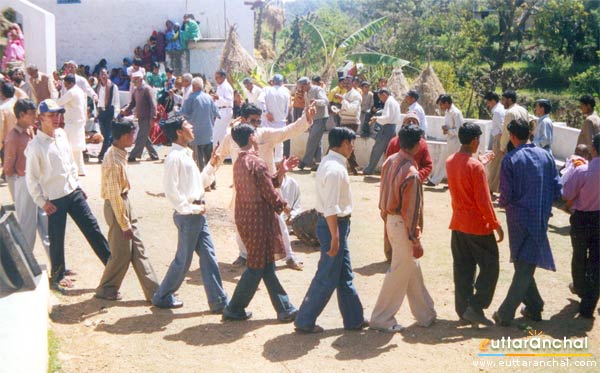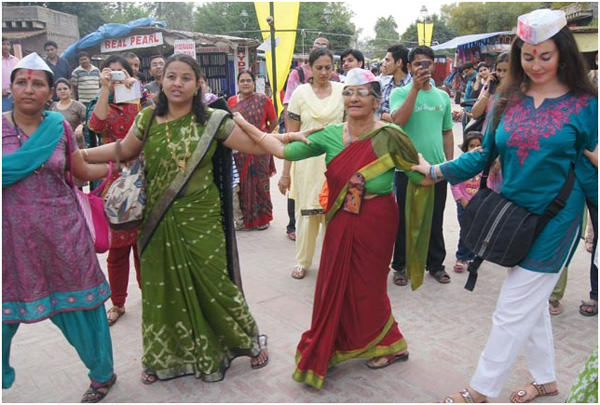Kumauni (Kumaoni) Holi, is the historical and cultural celebration of Holi in the region of Kumaon, Uttarakhand. It is one of the most important festivals for the Kumauni people as it signifies not only the victory of good over evil but also the end of the winter season and the start of the new sowing season which holds great importance for this agricultural community of the North Indian Himalayas.
The uniqueness of the Kumaoni Holi lies in its being a musical affair in the form of Baithki Holi, Khari Holi and the Mahila Holi. The Baithki Holi and Khari Holi are unique in that the songs on which they are based have a touch of melody, fun and spiritualism. These songs are essentially based on classical ragas. No wonder then the Baithki Holi is also known as Nirvan Ki Holi or Holi of Salvation.
Holi festival lasts for two months in Kumaun, and celebrated in a different way as compared to other parts of India.
The following are the various forms musical gatherings in which Holi songs are ceremonially sung which are viewed as the start of the Holi celebration. All of these celebrations in the form of musical gatherings start on the Basant Panchami Day.
Baithki Holi (Sitting Holi) is a form of musical gathering starting from the day of Basant Panchmi held all across Kumaon till the Dulhendi (or the last full moon day of the lunar month Phalguna). The Baithaki Holi songs are based on Classical Music with heavy influence of Kumaoni folk music traditions.
The Baithki Holi begins from the premises of temples, where Holiyars (the singers of Holi songs) and other people gather to sing songs with musical instruments like harmonium and tabla. The Baithaks or sittings are held in the local community centres and even at local homes.
Different songs are sung based on the time, such as, during noon the songs based on Pilu, Bhimpalasi and Sarang ragas are sung while evening is reserved for the songs based on the ragas like Kalyan, Shyamkalyan and Yaman etc. Most of the songs are religious in nature and concern tales from the life of the Hindu God Krishna.

Khadi Holi during noon in the Village Temple
Khadi Holi (Standing Holi) starts a little later than Baithaki Holi. The songs of the Khari Holi are sung by the people, sporting traditional white nokdaar topi, churidar payjama and kurta, dance in groups to the tune of ethnic musical instruments like the Dhol and Hurka.

Khadi Holi in Kumaon in Dwarahat (Ranikhet)
Men in groups singing Khadi Holi songs which are much more Kumaoni in flavour than the classical renditions of the Baithaki Holi visit different homes and greet the members of that house and chant hymns praying for prosperity of the householder. These groups of men are called Tolis. Khadi Holi is filled with excitement and frolic as opposed to the more sombre nature of the Baithaki Holi. Example of a few commonly sung Khadi Holi songs.
They are gatherings similar to Baithaki but composed exclusively of women.
Cheer Bandhan and Cheer Dahan: The Holika bonfire in Kumaun is known as Cheer, which is ceremonially made in a ceremony known as Cheer Bandhan fifteen days before Dulhendi. The Cheer is basically a bonfire with a green Paiya tree branch in the middle. The Cheer of every village and mohalla is rigorously guarded as rival mohallas try to steal the others cheer. The Cheer is burnt on the night before Holi and is known as Cheer Dahan is symbolic of the victory of the pious Prahlad over his evil father’s plans.
Why Kumaoni Holi is so special
Check Here
Chharadi (Dulhendi): Dulhendi known as Chharadi (from Chharad which means natural colours made from flower extracts, ash and water) is celebrated with Abeer and Gulal, in all possible colours. Next comes squirting of coloured water using pichkaris. Coloured water is prepared using Tesu flowers, which are first gathered from the trees, dried in the sun, and then ground up, and later mixed with water to produce orange-yellow coloured water.
Shubh Kamna: The culmination of the holi celebrations takes place with throwing abeer, gulal in the air and reciting out aloud in unison the following prayer in Kumaoni for a healthy and prosperous year ahead.

Villagers playing holi

Holi Celebrations Mahila Holi (Pic Src: Check Here)

Holi in Kumaon (Pic Src: Check Here
Just wanted to ask why we celebrate Holi ka tika on the very next day of Holi festival